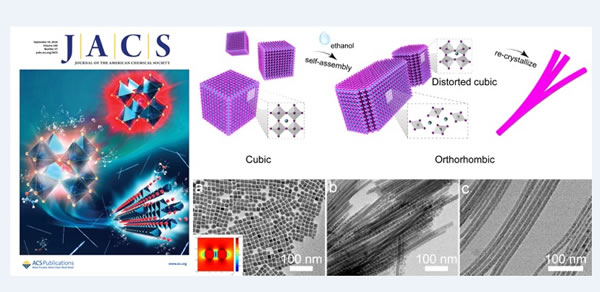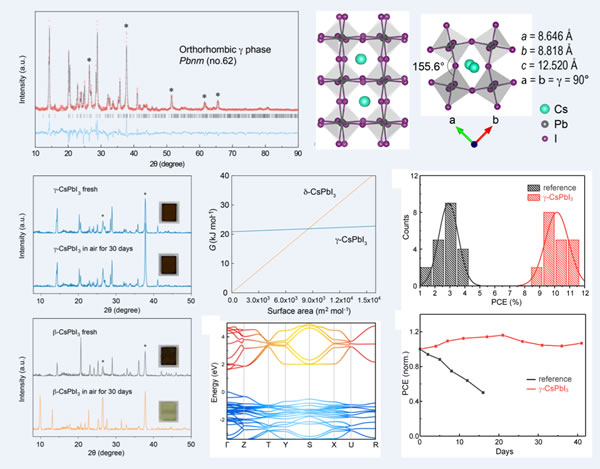The Institute of Chemistry of the Chinese Academy of Sciences has selected materials and devices for perovskite solar cells
In recent years, the rapid development of perovskite solar cells has attracted widespread attention from practitioners in the global photovoltaic industry and scientists from various countries. Its high solar energy conversion efficiency, simple preparation process and low manufacturing cost make it a hot star in academic and industrial circles. The important bottleneck and key problem of the practical application of perovskite solar cells is how to realize low-cost, large-area, high-efficiency devices and solve the stability problems.
With the support of the Strategic Leading Science and Technology Project of the Chinese Academy of Sciences and the National Natural Science Foundation of China, Hu Jinsong, a researcher of the Key Laboratory of Molecular Nanostructures and Nanotechnology, Institute of Chemistry, Chinese Academy of Sciences, has conducted systematic and in-depth research in this A series of new progress has been made recently with relevant collaborators. They developed an air knife coating method, which realized high-quality coating of large-area perovskite thin film, electron transport layer (ETL) and hole transport layer (HTL), without spin coating and anti-solvent in the whole process Under the circumstances, a battery device with a conversion efficiency (PCE) of more than 20% is obtained (Figure 1), which provides an idea for the low-cost and large-scale preparation of high-efficiency perovskite photovoltaic devices. The related work was published in the recent Joule (DOI: 10.1016 / j.joule.2018.10.025), the flagship energy journal of Cell Press. In terms of HTL, we developed a new low-cost, easily prepared two-dimensional conjugated organic small molecule hole transport material OMe-*** yr instead of spiro-OMeTAD, achieving an average PCE of 20% (Angew. Chem. Int. Ed . 2018, 57, 10959). In terms of ETL, the researchers found that in the absence of ETL, the Fermi level gap between the transparent electrode and the perovskite film is reduced, and the bending of the contact interface band is weakened, so the extraction of photogenerated electrons and the repulsion of photogenerated holes are also weakened. , The transfer efficiency of electrons at the interface drops sharply, leading to serious carrier recombination and device PCE reduction. This new understanding breaks through the traditional understanding of the structure of perovskite photovoltaic devices and the interface of heterojunctions, and explains the reasons for the low PCE of ETL-free devices. Based on this, a new solution to reduce the conversion efficiency of ETL-free perovskite photovoltaic devices by prolonging the carrier lifetime is proposed. It was found that when the carrier lifetime is close to microseconds, the PCE without ETL device can be close to the traditional pin structure device, and an ETL-free perovskite photovoltaic device with a PCE of 19.52% is obtained (Figure 2). These results are an important step for breaking through the dependence of perovskite devices on traditional device structures, and also provide in-depth understanding and diversified options for the theoretical research and low-cost large-scale preparation of perovskite photovoltaic technology. Related work was published in the flagship Chem journal of Cell Press (Chem, 2018, 4, 2405-2417).
The stability of the perovskite battery is the bottleneck and key to its application. The researchers introduced a high mobility hydrophobic conjugated polymer interface layer between the perovskite layer and the HTL, on the one hand to improve the extraction efficiency of holes, on the other hand, it can effectively block the erosion of the perovskite layer by additives in the moisture and transport layer, Thereby significantly improving the air stability and photoelectric conversion efficiency of perovskite solar cells (Solar RRL, DOI: 10.1002 / solr.201800232, inside cover; Nano Res., 2018, 11,185-194). Compared to organic-inorganic composite perovskite materials, pure inorganic perovskite materials exhibit more excellent thermal stability. Among them, the cubic phase CsPbI3 has a suitable band gap and attracts attention, but the cubic phase is a thermodynamically unstable phase at room temperature, so understand the phase instability mechanism of the cubic phase CsPbI3 in the synthesis and device preparation process, and then prepare at room temperature The phase-stable photovoltaic phase CsPbI3 is of great significance for its application in photovoltaic and photovoltaic fields. Researchers have recently observed for the first time on the atomic scale that polar solvents induce distortion of the cubic phase CsPbI3 nanocrystal lattice, which in turn leads to phase change instability. The experimental and theoretical explanation of the polar solvent's stability to the cubic phase CsPbI3 nanocrystal The effect reveals the mechanism of polar solvent-induced cubic phase CsPbI3 nanocube phase transformation and its multi-level self-assembly into single crystal nanowires and microwires (Figure 3). The results of this study provide a new understanding of the mechanism of cubic phase CsPbI3 instability, and provide guidance for the selection of solvents in the preparation and storage of cubic phase CsPbI3, and promote its application in the field of photovoltaics and photovoltaics. The related work was published on J. Am. Chem. Soc., 2018, 140, 11705–11715, and was selected as the current cover.
On this basis, the researchers developed a method to control the surface energy of the CsPbI3 perovskite precursor crystallized by high dielectric constant protic solvents without introducing organic ligands or metal / halogen doping Using a one-step solution deposition and low temperature annealing process, a new photovoltaic phase-orthogonal phase g-CsPbI3 thin film stable at room temperature was obtained. The cell parameters were determined by XRD refinement, the formation mechanism and energy band structure of the thin film were studied, and the planar heterojunction solar cell based on the g-CsPbI3 thin film was constructed, and 11.3% PCE was obtained (Figure 4). It is the highest efficiency of all inorganic pure CsPbI3 perovskite solar cells reported. Due to the thermodynamic stability of the resulting g-CsPbI3 film at room temperature, the battery exhibits significantly improved air stability for several months. This study reported for the first time that a new orthogonal photovoltaic phase g-CsPbI3 thin film and its high-efficiency battery device, which are thermodynamically stable at room temperature, provide a new perspective and ideas for solving the structural instability problem of all-inorganic CsPbI3 perovskite photovoltaic phase at room temperature. This work was serialized and published in full text in the form of J. Am. Chem. Soc., 2018, 140, 11716–11725.

Figure 1. High-efficiency perovskite solar cells prepared by air knife coating

Figure 2. High-efficiency electron-transport-free perovskite solar cell

Figure 3. Polar solvent induced lattice distortion of cubic phase CsPbI3 nanocrystals and its multi-order self-assembly

Figure 4. Room temperature thermodynamically stable orthogonal photovoltaic phase g-CsPbI3 thin film and all-inorganic perovskite solar cell
The Stainless Steel Ball Valve can be closed tightly with 90 degree rotation and small rotation torque. The completely equal inner cavity of the valve body provides the medium with a small resistance and a straight flow path. The main characteristics of Ball Valve are its compact structure, easy operation and maintenance. Stainless steel ball valve can be used to control the flow of air, water, steam, various corrosive media, mud, oil, liquid metal and radioactive medium. The valve body can be integral or combined. This kind of valve should be installed horizontally in the pipeline. Stainless steel ball valve classification: stainless steel Pneumatic Ball Valve, stainless steel Electric Ball Valve, stainless steel manual ball valve. Stainless steel ball valve material is divided into 304316321 stainless steel ball valve.
Stainless Steel Ball Valve
Stainless Steel Ball Valve, Stainless Steel Ball Valve by Flange, 2PC Threaded Stainless Steel Ball Valve
Ningbo RMI Plastic Co.,Ltd , https://www.rmiplast.com
